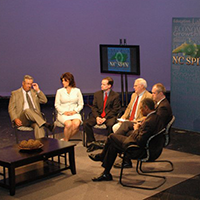Who are the people in your neighborhood
Published May 24, 2024
By Lib Campbell
Between Sesame Street and Mr. Rogers, ideals of neighborhood are remembered. “They’re the people that you meet when you’re walking down the street. They’re the people that you meet each day.” While that is the case on Sesame Street, a whole lot of us don’t live in neighborhoods where we know each other, hang out together, or share life in meaningful ways.
In Raleigh, some neighborhoods have such big lots, you’d have to pack a lunch to walk over for a visit. Today, we may recognize somebody’s car, and unless their name is on their license plate, not know who the driver is. Many neighborhoods do not have sidewalks. Walking anywhere is treacherous.
A couple in our neighborhood wanted to change the dynamic. They sent a flyer that read, “Come meet your new neighbors.” They hired a food truck and asked people to bring their chairs and beverages. The Sunday afternoon gathering was a smashing success. For an hour and a half, we were community, chatting, catching up, learning names. It was a grand affair.
We have always thought that television, air conditioning and the loss of the front porch impacted life to the point we stayed inside. Our neighborhoods changed as a result. Seems like modernization and technology negatively altered one of the great unifiers of our country and state, the neighborhood.
Perhaps when our children are little, there is more play outside together. Parents make play dates. Some parents gather while their children are together, but the children grow up. Soon come the afternoons of driving kids to all kinds of activities with other kids who likely are not from their neighborhood. They have acquaintances beyond the neighborhood. But who will parents call when a child has a fever in the middle of the night and a neighbor is needed to sit with the other children while they go to the emergency room?
We live on a street with a sidewalk. In thirty years, it’s the first neighborhood where we have sidewalks in good condition, and people walk their dogs and their baby carriages all day long. To know more names now and be able to share life is greater blessing than I realized it would be. Little children come to sit and visit. They will ring the doorbell and want to talk. Which is what we do. I keep lemonade on hand. Some bubbles. A little sidewalk chalk.
People come to look at the garden. This spring, Tom has raised many tomato plants from seed. He has given away about ninety plants to neighbors we didn’t even know before the neighborhood barbecue. Here in the heart of Raleigh, we have a patio filled with pots and cages of Better Boys, Cherokee Purples, Celebrities, and Sun Gold cherry tomatoes. There will be many BLTs in our summer. And likely tomatoes to share. We expect many visitors in tomato season. Blessings await!
The Thursday garbage can relay is a sight to behold. Trash cans are put out on the curb. On Thursday morning, the game is on. Tom and two neighbors across the street compete to bring each other’s cans to their back yards after the truck passes. Sometimes they are all three at the cans laughing and talking. Neighbors get together in lots of places.
There has been so much written about the problem of isolationism in the culture. People stay inside glued to their devices and essentially become recluses to their neighbors and even to their own families. Everything on the Internet, TikTok or YouTube is not community building. Some of the content, in fact, is not good for us. Many are attracted, then driven to dangerous people and actions. A genie has been let out of the bottle; there is likely no going back.
When our mothers would talk about their growing up in the 30s and 40s, they reminisced that people were connected through their neighborhoods and their churches. Tommie would talk about gathering around a piano and singing just for the joy of it. But both of those community building entities have lost their influence since that time.
People are lonely. Loneliness seeds depression, and maybe anger. But this train has left the station. Motivators other than community and neighborliness are in control. And look at the state of our state and our country. There is more that divides; less that unifies. For the most part, we seem alright with the division.
Sesame Street and Mr. Rogers capture a long-lost ideal that we would be a neighborhood, sharing life and stories, and even plants. “Please won’t you be my neighbor,” seems a quaint hope. Still, the experience of a neighborhood barbecue was a hopeful sign. Community takes effort. Seems to me, the effort would be well worth it.
Lib Campbell is a retired Methodist pastor, retreat leader, columnist and host of the blogsite www.avirtualchurch.com. She can be contacted at libcam05@gmail.com







